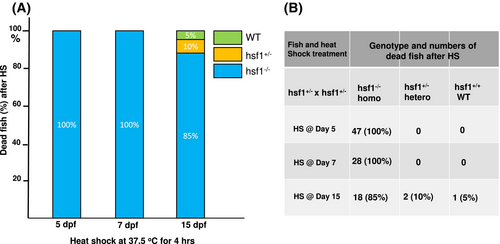|
Hsf1−/− mutant zebrafish larvae are more susceptible to environmental stress from HS. Fish embryos of WT (~25%), hsf1+/− heterozygous (~50%) and hsf1−/− homozygous (~25%) mutants were generated from the hsf1+/− heterozygous in-crossing. The above embryos of mixed genotypes were subjected to heat shock treatment at 37.5°C for 4 h on 5, 7, or 15 dpf. Dead embryos resulting from HS treatment were collected and individually genotyped. The percentage of dead embryos among the three genotypes are shown in figure A. At days 5 and 7, all the dead embryos were hsf1−/− homozygous mutants. On day 15, 85% of the dead embryos were hsf1−/− homozygous mutants, while the wildtype and heterozygous mutants only represented 5% and 10% of the dead embryos, respectively. The numbers of dead embryos of the three genotypes and their percentages among the dead embryos are listed in figure B.
|

